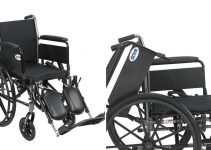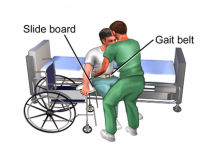A cane is an assistive device used as a walking aid to make moving around safer and less painful.

People need to use canes for many different reasons. Whether prescribed to you for a short period by a physical therapist after knee surgery or for long-term use for generally aiding balance and mobility. But if this is your first time, you may be wondering how to walk with a cane correctly.
Simply put, to use a cane correctly, you should put the cane on the side of your “unaffected” leg, then move your cane forward with your “affected” leg at the same time.
Want to know more details? We prepared a comprehensive guide to help you walk with a cane properly.
do You Need To Use A cane?
As we age, our mobility can become restricted, and something as simple as walking can become painful.
However, using a cane is not restricted to the elderly. Many people use a cane to aid walking after an injury.
Using a cane for assistance when walking can be helpful in a variety of circumstances. Here are some of the top reasons you may consider using a cane:
- If you are concerned about falling and injuring yourself while walking.
- In instances where you are unable to walk without pain daily.
- If moving up and down stairs has become a challenge.
- After knee, hip or foot surgery.
- You tend to look for some supportive fixture to balance yourself while walking.
If you are having trouble with any of the issues listed above, you may find using a cane beneficial. But, the exact problem itself will determine what type you should use, for example, whether you need a cane for balance or one for weight-bearing.
In addition, a walking cane is a type of walking aid for minimal balance issues, for more severe situations, a walker or a wheelchair may be a more suitable choice. Always consult your doctor before making any purchase.
Considerations When Choosing A Cane
Here are some quick cane tips to help you select the correct cane for your needs.
Types of Cane
Canes come in a range of shapes and sizes, depending on their intended use. Below are the different types of canes and their uses and benefits.
Single-Point Canes
A standard cane, also known as a single-point cane, is the most commonly found amongst cane users. These are usually metal or wooden canes.
The aluminum variety of cane tends to be adjustable, meaning that it’s not imperative to get the perfect height. They also tend to be collapsible canes which makes them more convenient when traveling.
Offset Canes
Offset canes are similar to single-point canes, except they have a different shape, allowing you to occasionally use the cane for weight-bearing.
Offset canes are most suited to people who suffer from arthritis pain in the hip or knee that sometimes need to have less body weight on their painful leg.
Four-Footed (Quad) Cane
Quad canes are the best canes for balance. These have four short legs attached to a base that allows for more stability—some even come with a pivoting quad base. These canes are often best used for those with more severe mobility issues or those that are at greater risk of falling.
Seat Canes
Seat canes, as suggested by the name, come with a small seat and offer the user the ability to take short breaks and sit down when needed.
Think About Cane Height
Ensuring your cane is the right height for you is imperative because you want to use your cane freely—especially if you are in pain. Plus, for those with more extensive mobility issues, using a cane with an incorrect height can place them at a higher risk of falling and injuring themselves.
When holding your cane, your elbow should be at around a 15-degree to 20-degree angle to assist your balance.
Although on average, the correct height of a cane is around half the user’s height, it is advantageous wherever possible to fit your cane correctly. You can do this by:
- When trying a cane, be sure to wear your normal shoes and stand upright.
- Make sure you keep your arms relaxed and hold your elbow at a comfortable angle which is about 20-degree.
- Measure the distance between the floor and the crease in your wrist.
Consider Your Cane’s Grip
You want your cane to be comfortable to use regardless of how often you plan on using it. However, for those who require more frequent use, the cane handle will ultimately put more stress on their hand.
Ideally, for regular cane users, an orthopedic grip or a foam grip can offer both comfort and ease of use.
See also our post about the best walking canes for elderly.
How To Use A Cane
Once you have chosen a cane that suits your needs and fits you correctly, it is time to get moving. Below are some tips on how you can use a cane safely and comfortably.
The Basics: How To Walk With A Cane Properly

Walking with a cane can make a huge difference to your everyday life if you need help with balance. They can aid your safety and help prevent a fall. But, using this mobility aid takes practice.
Here are the basic steps to get you started:
- Hold your cane steady at a comfortable angle on the opposite side of your affected leg. For example, if you have pain in your left foot, hold the cane in your right hand.
- When walking with your cane, move your cane forward and step forward with your weak leg at the same time.
- Keep a firm grip on your cane while it remains in place as you step forward with your unaffected leg.
- Always try to keep your cane slightly forward and to the side of your body.
- Look straight ahead and not down at your feet.
It is best to ask someone to assist you before you get used to use a cane. Someone may need to help you with additional support and stability until you feel entirely confident, be it a doctor, other health professional, or a loved one.
We also found a good and interesting video below to guide you how to walk with a cane step by step.
Using Your Cane On Stairs
Once you have the basics mastered, it is time to look at more advanced cane use. Using a cane on stairs takes practice.
- Always hold the handrail if avaliable.
- Wherever possible, try to position yourself so that the handrail is on the opposite side of the hand holding the cane.
- When going upstairs, step first with your strongest leg, followed by your cane and your weaker leg at the same time.
- When going downstairs, keep your weight on your strong leg and move your cane down to the step below you. Then follow with your weaker leg so that it is now on the same step as your cane and finally, step down with your strong leg.
Sitting Down Into A Chair
For safety reasons, it is never a good idea to put your full weight onto a cane when standing up or sitting down, especially if you are less steady on your feet. When sitting down in a chair you should:
- Move backward until you feel the edge of the chair against the back of your legs.
- Holding the cane in one hand, place your other hand on the arm of the chair for support.
- Slowly and carefully lower yourself down into the chair.
Common Mistakes People Make When Using A Cane
Of course, as you get accustomed to your new walking aid, it is likely you will make mistakes along the way. So, it is important to be aware of the main issues faced by people when using a cane to spot and rectify them if they occur.
- Having poor posture.
- Placing the cane too far from the body.
- Allowing the cane to drag when you walk.
- Poor timing when using the cane.
- Holding the cane on the side of your injury.
When To Use A Cane
Just because you have a cane doesn’t mean you necessarily need to use it all of the time. For example, those who use a walking aid to help with pain management such as an arthritis patient may only need to use a cane during an arthritis flare rather than permanently.
You may be able to manage without a cane on a day-to-day basis going about your regular duties and only need a cane in unfamiliar surroundings or places with uneven terrain, or at certain times of the year when the ground is more slippery due to the weather.
In Closing
Whether through infirmity or injury, many people need to use a cane at some time or other. If it is your first time with a cane, it may be advisable to seek professional help from a physician or physical therapist.However, following the basic steps we’ve laid out will ensure that you use your cane correctly, and this can help you to stay active, feel confident and use your mobility device with pride.



